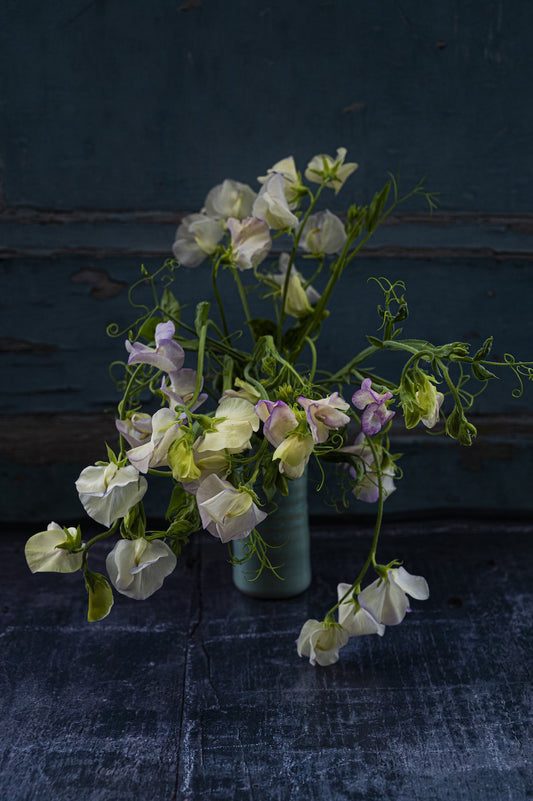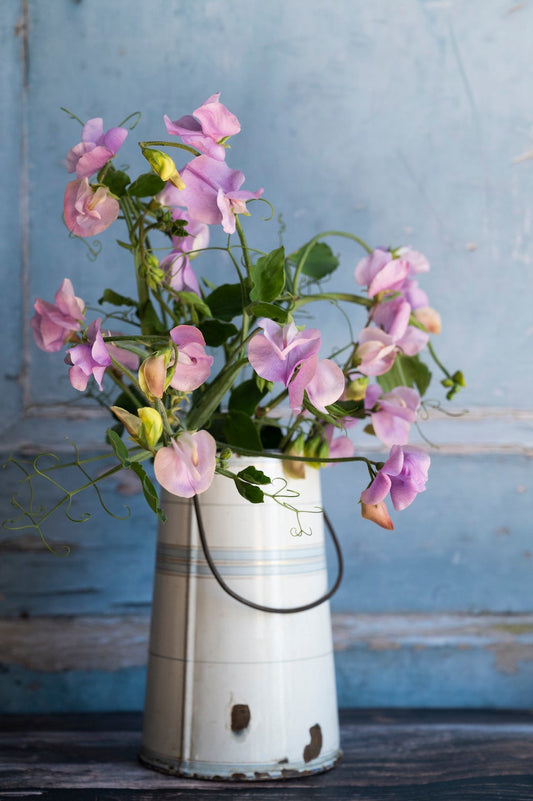SWEET PEACHES – About the happiness and scent of summer
The world needs more sweet peas. I think so. And apparently, I'm not the only one. In England, a society was actually founded just for them—The National Sweet Pea Society. I love them (the English and the sweet peas).

Here you can see Cupani – one of the oldest sweet peas ever
It's also called "sweet pea" and is actually related to the vegetable on our plates. Now close your eyes and imagine yourself strolling through your garden. Imagine the seductive, sweet scent of the carefree summer with every step. And even better in real life! Strangely enough, it took a few years for sweet peas to become a part of my garden. I have no idea why, but somehow I just hadn't noticed them. But now, year after year, there are more and more of them. And there are always new varieties!

COLORFUL FENCES AND FRAGRANT BEDS
From brilliant white to delightful pink, gorgeous pink, red, dark red and bright blue (or even delicate pastels) to dramatic purple, these annual, lushly flowering climbers bring romance and lightness to your garden and the colors of summer to your bouquet.


Sweet Pea High Scent

Sweet Pea Singing the Blues
You can find the complete sweet pea collection HERE .
Over the course of a season, their flowers can charmingly "prettify" an ugly chain-link fence or other (hidden) objects. Potted sweet peas also enhance balconies and patios. Their flowering period extends from June well into autumn, and depending on the variety, they grow up to two meters tall. The climbers require support or trellises. This can be twigs, string, wire, or, what looks particularly attractive: raising their colorful little heads on a fence. Preferably a picket fence, of course, or a white wooden slatted fence.

BEFORE A SENTENCE ON SOWING:
The National Sweet Pea Society website states the following sentence:
"Hints on Growing – It was originally intended that this Section should be headed "How to Grow" but since there are so many opinions from different people, many of them contradictory, it is considered that there is no "right" way and so what follows is more properly considered to be hints."
Translated:
"Sowing Instructions – This section was originally intended to be titled "The Correct Sowing," but since there are many, sometimes conflicting, opinions on this topic, we assume that there is no "right" way and limit ourselves to suggestions."
I love them. The English. Did I mention that? And that's how sowing works for me.
SOWING IN THE HOUSE
You can start sweet peas indoors early in the year. Or even as early as early fall, then let them overwinter under fleece. Beware of excessive frost; a greenhouse would be ideal.
Use tall pots from the start – sweet peas quickly grow deep roots and are grateful when they can stretch out their little feet.
Very important: Soak the seeds overnight (this softens the seed coat and the vetch germinates faster and more reliably) and then plant them. And yes, it does make a difference in how quickly they germinate. Video proof is HERE .
They need light (ideally grow lights) and a kind word every now and then. Never let the seeds dry out. Move the young seedlings outside when severe frosts are no longer expected. Gradually acclimate them to the colder outside temperature. I've had my sweet peas outside since the beginning of April this year (it's been very mild). If another serious frost is on the horizon, I cover them with fleece.
SOWING OUTDOORS
Of course, you can also sow them directly outside without any problems. Here, too, soak the seeds in water overnight beforehand. Then you can sow them about 1.5 centimeters deep into the prepared soil or pot and water them thoroughly. You can also use seed pots and plant them later in the garden. The first seedlings usually appear after five to ten days.

I grow my sweet peas indoors in warmer temperatures. But as soon as they peek out of the soil, they come out.
If you have sown them directly into the bed, the seedlings (from about 10 cm in size) should be spaced 20 - 30 cm apart.
In principle, sweet peas can also be sown in late summer/early autumn (in milder regions this is even highly recommended), then they will bloom up to six weeks earlier and for longer the following year.
If you have a greenhouse, you can grow sweet peas there. They should be kept cool, as they tolerate light frost. In severe frost, it's best to cover them with fleece or film.
Tweezing
If you want a bushier, more lush growth, trim the top of the plant above the second or third pair of leaves. This encourages more side shoots to grow. I don't pinch all of them, but let a few grow simply because I'm curious and like to observe the difference. (Update: I didn't notice much of a difference last year.)

LOCATION AND CARE
As for the location, sweet peas prefer a sunny spot, but in a pinch, they will also tolerate partial shade. Too much draft (a sheltered spot would be ideal) and, above all, waterlogging should be avoided. Apparently, even full midday sun is a good option – I haven't experienced that.
Be sure to water during dry periods! Regular fertilization will reward them with unbeatable blooms. Ideally, when the plants are about 10 cm tall, they should be covered with nutrient-rich soil. They will then form new roots and be able to absorb more nutrients and water.
It's best to prepare the soil for them with compost or well-rotted manure. They'll thank you with plenty of flowers. They also need regular water. A drip irrigation system would be ideal.

AND VERY IMPORTANT:
Cut off plenty of flower stems (in the morning!) for your summer table setting. The more you cut, the more flowers the sweet pea will give you. Ideally, you don't let it set seeds, otherwise it will soon stop flowering. Or, translated in "sweet pea" terms: My job is done. I've reproduced, now I don't need any more flowers.

PERENNIALS
If sowing annually is too much work for you, then take a look at perennial sweet peas . They're just as charming—but without the fragrance. Growing them is very similar.

And I had to laugh at this sentence from the National Sweet Pea Society: "Germination can take anything between two weeks and two years, so be patient." (Seedlings appear after two weeks to two years, so you'll need to be patient.)
For me, it worked quickly this year (after just two weeks!), and I'm very grateful for that.
Are you spoiled for choice? Then check out my sweet pea mix that I've put together for you:


Photos: Janina Laszlo, Flora Press/Visions
Sweet pea Erewhon .


































